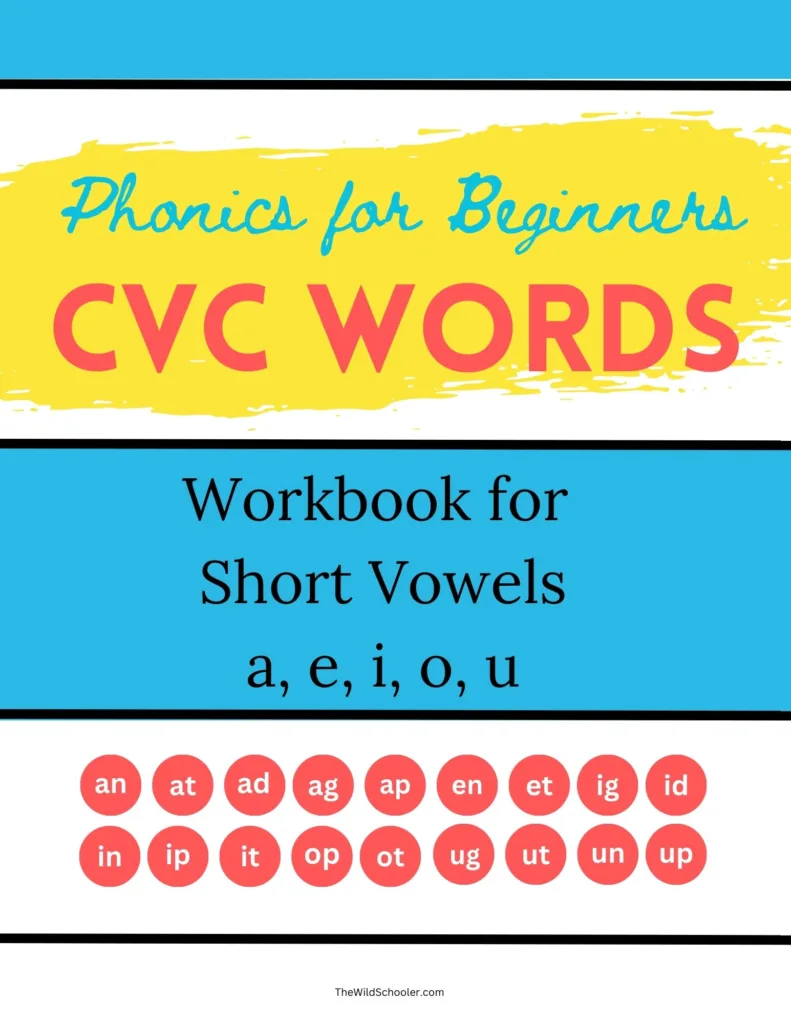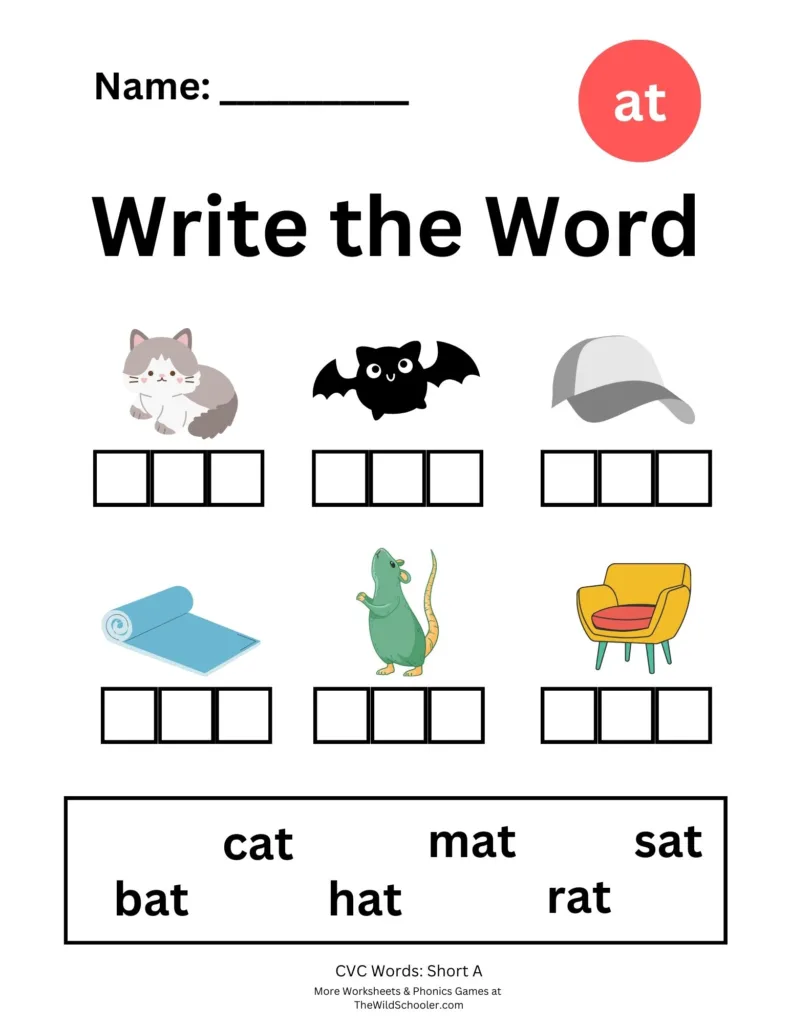The debate about how to teach children to read has been ongoing for decades. Traditional school-taught reading methods often rely on memorizing whole words and sentences, while phonics has emerged as a more effective and systematic approach. Phonics is the method that helps children understand the fundamental building blocks of language, enabling them to decode and read words independently. In this comprehensive guide of CVC Words, we’ll explore why the phonics method is superior to traditional approaches, introduce you to CVC words, and provide a list of CVC words to help young learners on their reading journey.
We try to incorporate multiple learning media when teaching our kids to read. This guide will provide short videos, workbooks, engaging phonics exercises and fun phonics games to keep your child interested in learning to read.
Here’s a short video lesson on CVC words with the Short A sound that you can use as a lesson with your little one today.
At the bottom of this post, you will find a free phonics workbook on all the short vowel sounds so your kids can practice writing and reading them.
The Power of Phonics
Phonics instruction is a proven method for teaching children how to read. It’s based on the concept that each letter or combination of letters represents a sound, and these sounds can be blended together to form words. This phonetic approach empowers children to read words they have never seen before by sounding them out, which is an essential skill for independent reading and literacy.
Why Phonics is Better
Systematic Approach: Phonics provides a structured, step-by-step process for learning to read. It begins with the most basic building blocks, teaching children to recognize individual letter sounds and their combinations.
Independence: With phonics, children are equipped with the tools to read new and unfamiliar words on their own. They are not limited to memorizing a fixed set of words.
Word Decoding: Phonics enables students to decode words by breaking them down into their constituent sounds. This skill is invaluable when faced with unfamiliar vocabulary.
Improved Spelling: Understanding the relationship between letters and sounds helps children become better spellers. They can apply their knowledge of phonics to both reading and writing.
Strong Foundation: Phonics provides a strong foundation for reading comprehension. When children can effortlessly read individual words, they can focus on understanding the meaning of the text.
Engagement: Phonics instruction can be interactive and engaging through activities, games, and hands-on learning, making reading enjoyable for children.
Now that we’ve explored the advantages of phonics, let’s dive in.
CVC Words – What Are They?
CVC words are a vital part of early phonics instruction. The term “CVC” stands for Consonant-Vowel-Consonant, and these words are exactly what they sound like—words composed of a consonant, a vowel, and another consonant. These words are simple and serve as building blocks for more complex vocabulary. By mastering CVC words, children can apply their knowledge to read and spell a wide range of words.
Click here to get a free workbook that will teach your child to decode and read CVC words with short vowels. This is the first step in learning to read with phonics after they’ve learned the individual letters and their sounds.

The Importance of CVC Words
- Simplicity: CVC words are straightforward and easy to understand for early readers. They provide a starting point for learning to decode words.
- Sound Recognition: They help children recognize individual letter sounds and understand how they come together to form words.
- Reading Fluency: Mastering CVC words contributes to reading fluency, as they serve as a bridge to more complex texts.
- Spelling Proficiency: Learning CVC words enhances spelling skills as children begin to grasp the relationship between sounds and letters.
List of CVC Words
Now, let’s explore a list of CVC words, grouped by their ending sounds. It’s essential to introduce these words to children in a systematic order to help them progress in their reading journey. Here are some common CVC word endings in the order they should be introduced.
-an
- can
- fan
- man
- pan
- ran
- van
-at
- bat
- cat
- hat
- mat
- pat
- rat
- sat
-en
- den
- hen
- pen
- ten
- men
- when
-ig
- big
- dig
- fig
- pig
- rig
- wig
-it
- bit
- fit
- hit
- kit
- lit
- sit
-op
- bop
- cop
- hop
- mop
- pop
- top
-ug
- bug
- dug
- hug
- jug
- rug
- tug
-et
- bet
- get
- jet
- let
- met
- pet
- vet
- wet
- yet
-ot
- cot
- dot
- hot
- lot
- pot
- tot
-ed
- bed
- fed
- led
- red
- wed
-ap
- cap
- lap
- map
- nap
- rap
- tap
-ip
- dip
- hip
- lip
- nip
- rip
- sip
- tip
-ox
- box
- fox
- lox
- pox
Teaching CVC Words
When introducing CVC words to young learners, it’s crucial to follow a systematic approach, just as in phonics instruction. Start with the simplest word endings like ‘-at,’ ‘-an,’ and ‘-it.’ Once your students are comfortable with these, gradually progress to more complex word endings. Engage them in fun, interactive activities and games to reinforce their learning.
CVC Phonics Games:
Incorporate phonics games like word building with magnetic letters, CVC word bingo, or The Letter Hunt, an outdoor game designed to enhance CVC word recognition.


CVC Word Cards:
Create word cards with CVC words and corresponding pictures. Encourage students to match the words to the pictures, reinforcing their understanding of these words. Here are some free printables you can cut out and use today.

Decodable Books with CVC Words:
Provide decodable books that contain CVC words. These books are designed to gradually increase in complexity, helping students practice their newly acquired reading skills.
CVC Word Families:
Explore word families like the ‘at’ family (cat, mat, hat) or the ‘it’ family (sit, lit, kit) to help students identify common phonetic patterns in words. Here is a free CVC word workbook that you can print out. It includes a worksheet on all 3-letter CVC words using short vowels (a, e, i, o, u), like the image below.

By following a structured and engaging approach to teaching CVC words, you can empower young learners with the foundational reading skills they need to become confident and independent readers.
The phonics method offers a systematic and effective approach to teaching children to read, with CVC words serving as a vital building block in their reading journey. As students master CVC words, the next step is to start teaching digraphs, which are pairs of letters that create unique sounds such as sh, ch, ck, and th. In our next blog post, we will explore how digraphs contribute to advanced reading skills and provide a comprehensive list of common digraphs to further enhance your child’s reading abilities.












